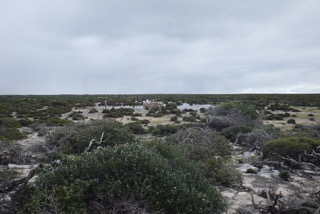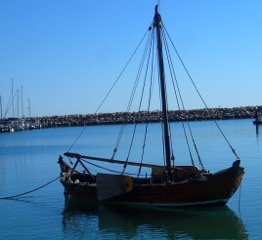Shipwreck

VulcanSpirit
Richard & Alison Brunstrom
Mon 20 Jul 2015 23:34
| The Dutch realised quite early on that they could get to their colony at Batavia (now Jakarta), having rounded the Cape of Good Hope in South Africa, more easily by following a parallel of latitude due east until they reached the Australian coast then turning left and heading north to what is now Indonesia. However this was before the wonderful Harrison had solved the longitude problem so there were a few tragic mishaps when Dutch ships, instead of turning north upon reaching Australia actually ran straight onto the continent or its offlying islands. Two of the most famous wrecks, for different reasons, are those of the ‘Batavia’ and the later ’Zuytdorp” The Batavia was a new ship belonging to the Dutch East India Company which came ashore in the Abrolhos islands on 04.06.1629, the inexperienced lookout having mistaken the line of surf for moonlight reflecting off the sea. There were well over 300 people on board, most of whom survived the wreck. The captain, Pelsaert, realising that there was insufficient water to sustain the crew, set off for Jakarta in the ship’s 9m open longboat with a few crew and some of the passengers - a journey to rival that of Bligh. The remainder were left behind. Mutiny had been brewing for some time, unbeknownst to Pelsaert. After he left matters took a very ugly turn. Jeronimus Cornelisz, who had left Europe to avoid arrest, took charge. He managed to maroon most of the soldiers on board on West Wallabi island under the pretext of looking for water - they were to light signal fires if they were successful. Cornelisz expected them to die. The remaining survivors were split up into smaller groups and distributed around several neighbouring islands. An orgy of murder then ensued for reasons that are not clear. At least 110 survivors, men women and children, were killed by Cornelisz’s gang. The soldiers meanwhile miraculously had found water. They were alerted to the murders by escapees, and set about defending themselves under the leadership of a common soldier, Weibbe Heyes. Heyes and his men successfully fought off several attacks by the mutineers, and built themselves a small redoubt of coral blocks. Incredibly, actually during one of these attacks Pelsaert returned and a frantic race ensued to get out to his ship first, which Heyes won. Cornelisz and several mutineers were tortured and hung, and two were set ashore on the mainland near Kalbarri. Of the crew of over 300 people, 68 eventually reached Batavia. Heyes was feted as a hero, was promoted to Sgt and then Lieutenant. Pelsaert was part-blamed for the disaster and died a broken man a year later. The crew of the Vulcan Spirit visited the site of Heyes' heroic defence on West Wallabi island nearly three hundred years before. Here is one of the signal fireplaces:  And Heyes’ little fort. Note that it is situated in a large bowl-shaped depression in the limestone, with standing freshwater (this being winter):   The WA museum at Geraldton has a replica of Pelsaert’s longboat:  And a replica of the Batavia itself can be seen at Lelystad in The Netherlands. The Zuydorp came ashore near Kalbarri in June 1712. There were nearly 300 people on board and there were no eventual survivors although it is now proved that some people survived the wreck and lived ashore close to the site for a few months at least. As far as the Dutch were concerned the ship simply vanished. The wreck site was not found until the 1980s, in a very inhospitable place indeed. Early exploration showed a carpet of silver coins on the seabed (these eventually proved the ship to be the Zuytdorp as they had been freshly minted and are known to have been carried specifically by the Zuytdorp. At the time Australia had little or no legal protection for historic wrecks and a heated debate ensued between those who believed the law of salvage to apply (basically finders keepers) and those led by the WA museum who wished to protect the site as an archaeological treasure. Being the Australian outback this debate descended to violence, the museum’s site caravan being burnt to the ground. In the absence of law the museum retreated for a few years. When they returned in 1986, armed with conservancy powers, it transpired that the treasure trove of silver had disappeared in the interim. The identity of the ‘thief’ has never been proven, and the silver has not reappeared. The WA museum in Geraldton does have a fascinating exhibit recovered from the wreck - a formal stone arch town gateway intended for Batavia/Jakarta. Interestingly a contemporary print has survived showing Batavia in 1712, with scaffolding up where the gate was to go, seen here in the centre of the wall towards the bottom of the picture:  And here is the actual gate:  A later engraving shows Batavia complete with gateway, so a replacement must have been sent out when the Zuytdorp disappeared. |